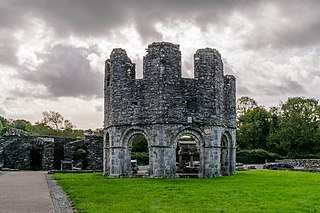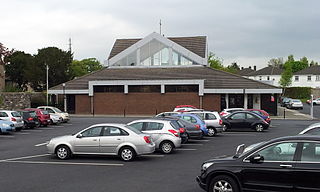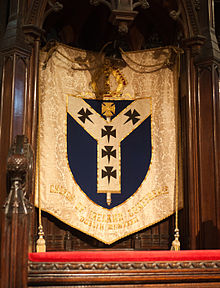
Saint Patrick's Cathedral in Dublin, Ireland, founded in 1191 as a Roman Catholic cathedral, is currently the national cathedral of the Church of Ireland. Christ Church Cathedral, also a Church of Ireland cathedral in Dublin, is designated as the local cathedral of the Diocese of Dublin and Glendalough.

Christ Church Cathedral, more formally The Cathedral of the Holy Trinity, is the cathedral of the United Dioceses of Dublin and Glendalough and the cathedral of the ecclesiastical province of the United Provinces of Dublin and Cashel in the (Anglican) Church of Ireland. It is situated in Dublin, Ireland, and is the elder of the capital city's two medieval cathedrals, the other being St Patrick's Cathedral.

Lorcán Ua Tuathail, known in English as Laurence O'Toole and in French as Laurent d'Eu, was Archbishop of Dublin at the time of the Norman invasion of Ireland. Lorcán played a prominent role in the Irish Church Reform Movement of the 12th century and mediated between the parties during and after the invasion. He was canonised in 1225 by Pope Honorius III.

The Synod of Ráth Breasail was an Irish Catholic church council which took place in Ireland in 1111. It marked the transition of the Irish church from a monastic to a diocesan and parish-based church. Many Irish present-day dioceses trace their boundaries to decisions made at the synod.
Cellach of Armagh or Celsus or Celestinus (1080–1129) was Archbishop of Armagh and an important contributor to the reform of the Irish church in the twelfth century. He is venerated in the Roman Catholic Church as Saint Cellach. Though a member of the laicised ecclesiastical dynasty of Clann Sínaig, he took holy vows and gained priestly ordination. This put an end to the anomalous state of affairs, in effect since 966, whereby the supreme head of the Irish Church had been a layman. Following the Synod of Ráith Bressail, in which a diocesan structure for Ireland was established, he became the first metropolitan primate of all Ireland.

The Synod of Kells took place in 1152, under the presidency of Giovanni Cardinal Paparoni, and continued the process begun at the Synod of Ráth Breasail (1111) of reforming the Irish church. The sessions were divided between the abbeys of Kells and Mellifont, and in later times the synod has been called the Synod of Kells-Mellifont and the Synod of Mellifont-Kells.

The Archdiocese of Dublin is an ecclesiastical territory or archdiocese of the Catholic Church located in the eastern part of Ireland. Its archepiscopal see includes the republic's capital city – Dublin. The cathedral church of the archdiocese is St Mary's Pro-Cathedral. Dublin was formally recognised as a metropolitan province in 1152 by the Synod of Kells. Its second archbishop, Lorcán Ua Tuathail, is also its patron saint.

The Parish of Taney is a populous parish in the Church of Ireland, located in the Dundrum area of Dublin.

St. Assam's is the name of two historic churches in the village of Raheny, Dublin, one a ruin in the middle of the village, one the structurally sound but no longer primary church built for the local Roman Catholic community of the area after the revival of religious rights. Both buildings lie within the area of the ráth which gave the village and district its name, and which was perhaps 110 m across.
Coolock is an ecclesiastical parish of the Church of Ireland located in Dublin, Ireland. It is one of two successors to the ancient parish of that name, the other being the ongoing Roman Catholic parish of St Brendan.

St Brendan's is a parish in Coolock, Dublin in Ireland that is served by the Church of St Brendan. The parish is in the Fingal South East deanery of the Roman Catholic Archdiocese of Dublin. The parish is based on the civil parish of Coolock. During penal times, it was one of the few functioning Catholic parishes in Dublin.
Founded in the early days of Irish Christian parish structures, the Parish of Clontarf assumed in 1829 the mantle of Union Parish for a large area of north Dublin, Ireland, a role previously filled by the Parish of Coolock, into which Clontarf had been subsumed in 1614 - refer to that article for history from 1618 to 1879. Clontarf itself is a large northside suburb of Dublin, and the parish was in the 20th century divided into the modern parishes which now serve that area.

The Archbishop of Dublin is a senior bishop in the Church of Ireland, second only to the Archbishop of Armagh. The archbishop is the diocesan bishop of the United Dioceses of Dublin and Glendalough and the metropolitan bishop of the Province of Dublin, which covers the southern half of Ireland, and he is styled Primate of Ireland.
The Parish of Raheny is the modern successor in the Roman Catholic Church to an early (1152) parish, in Raheny, a district of Dublin, Ireland, reputed to be a site of Christian settlement back to at least 570 A.D. Today's parish, within the Howth Deanery of the Roman Catholic Archdiocese of Dublin, comprises Raheny village and the central portion of the district, parts of which are also served by the parishes of Killester, Grange Park and Kilbarrack-Foxfield. The parish has a membership of around 10,000 Catholics. Similarly centred, and covering a greater land area but a much smaller membership, is the Church of Ireland parish of the same name.
The Parish of Raheny is the modern successor in the Church of Ireland to an early (1152) parish, in Raheny, a district of Dublin reputed to be a site of Christian settlement back to 570. Today's parish comprises Raheny village and the wider district, and is in a Union with the Parish of Coolock. Its parish church is All Saints' Church, Raheny.
The Archbishop of Dublin is the head of the Archdiocese of Dublin in the Catholic Church, responsible for its spiritual and administrative needs. The office has existed since 1152, in succession to a regular bishopric since 1028. The archdiocese is the metropolitan see of the ecclesiastical province of Dublin, and the archbishop is also styled the Primate of Ireland. The cathedral church of the archdiocese is Saint Mary's Pro-Cathedral in Dublin city, although the Church formally claims Christ Church as its cathedra, and the archbishop's residence is Archbishop's House in Drumcondra.
Dúnán was the first bishop of Dublin, appointed under Dublin's Hiberno-Norse kings. He is known also as Donatus or Donat. The diocese was put on a regular basis, in 1028, at the request of Sigtrygg Silkbeard. In his obit in the Annals of Ulster Dúnán is described as "chief bishop of the foreigners".

The Archbishop of Dublin is an archepiscopal title which takes its name after Dublin, Ireland. Since the Reformation, there have been parallel apostolic successions to the title: one in the Catholic Church and the other in the Church of Ireland. The archbishop of each denomination also holds the title of Primate of Ireland.
The pre-Reformation Christian church in Ireland was first divided into dioceses at the Synod of Ráth Breasail in 1111, although the dioceses of Dublin and Waterford were founded earlier by Hiberno Norse rulers with bishops consecrated by the Archbishop of Canterbury in England. The boundaries were reconfigured at the Synod of Kells in 1152 into 37 dioceses. A few were later abolished, as when Glendalough merged Dublin in 1214–16.













